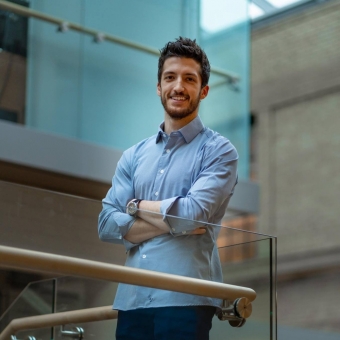abstract
Excitations in ferroic materials, such as domain walls and skyrmions, provide a rich playground for studying intriguing physical phenomena such as chirality, magnetic dynamics, spin-orbit coupling, and magnetoelectric coupling. Additionally, these excitations hold vast technological potential. Domain walls and skyrmions, which can be nucleated, annihilated, and translated by currents, provide a promising approach to encode bits of information for next-generation memory and logic. One technological and scientific challenge is to stabilize small spin textures and manipulate them efficiently with high velocities. This is critical for dense, power efficient, and fast memory and logic. However, in ferromagnetic materials, current-driven spin texture dynamics face an intrinsic “speed limit” and room-temperature-stable magnetic skyrmions are an order of magnitude too large to be useful in any competitive technologies. Furthermore, the energy requirements for current-driven manipulation of magnetism are orders-of-magnitude too large for practical devices.
Here, by synthesizing and engineering new classes of chiral magnetic materials and emergent magnetoelectric materials, we overcome these fundamental limitations plaguing traditional spintronic systems. Specifically, by using a combination of epitaxial growth techniques, interface design1, and magnetic sublattice engineering2, we stabilize 10 nm skyrmion bits at room temperature2, drive magnetic domain walls to velocities over 4,300 m/s3, and demonstrate low-power control of magnetoelectric chiral textures4. Moreover, by using advanced electrical and optical techniques (and developing new ones)5, we show that these systems provide a new platform to study complex fundamental phenomena like topology, inversion symmetry, and even relativistic dynamics.
1. Caretta, L. et al. Interfacial Dzyaloshinskii-Moriya Interaction Arising from Rare-Earth Orbital Magnetism in Insulating Magnetic Oxides. Nat. Commun. 11, 1090 (2019).
2. Caretta, L. et al. Fast Current-Driven Domain Walls and Small Skyrmions in a Compensated Ferrimagnet. Nat. Nanotechnol. 13, 1154–1160 (2018).
3. Caretta, L. et al. Relativistic Kinematics of a Magnetic Soliton. Science 1442, 1438–1442 (2019).
4. Caretta, L. et al. Electric Field Control of Inversion Symmetry. in preparation. (2021).
5. Caretta, L. et al. All-Optical Motion of Chiral Domain Walls and Skyrmion Bubbles. under review. (2021).
bio
Dr. Lucas Caretta is a University of California President’s Postdoctoral Fellow and a Ford Foundation Postdoctoral Fellow at UC, Berkeley working with Professor Ramamoorthy Ramesh. Caretta completed his Ph.D. in Materials Science and Engineering at the Massachusetts Institute of Technology under the supervision of Professor Geoffrey Beach. There, he made significant contributions to the understanding of magnetic soliton dynamics in compensated systems. His current research interests focus on developing new material systems and in-situ techniques to manipulate ferroic excitations and dynamics in nanoscale thin films. One of the most promising prospects in magnetism and ferroelectricity is the ability to control the magnetic state of a material using low-power electrical and optical stimuli. This allows for harnessing the coupling between spin, charge, and orbital degrees of freedom. Not only does this have great technological implications, but also provides an arena to investigate a variety of new, fundamental physical phenomena, such as topology, crystal symmetry, and even special relativity. Studying these phenomena requires electrical and optical probes that push experimental limits to the fastest timescales, the smallest length scales, and highest sensitivity. Much of Caretta’s work is dedicated to improving these techniques to help push ferroic research, and its technology, further.
Hosted by Ram Seshadri and Stephen Wilson. Download event flyer.




